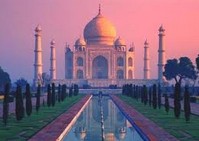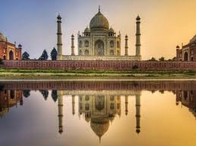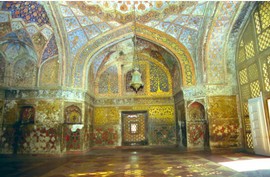Every year, thousands of tourists board an express train or hire a car in New Delhi and journey to Agra2) on a pilgrimage3) to the Taj Mahal. To the Western World, the image of the curved white domes4) of the Taj Mahal, displayed endlessly on travel brochures, is synonymous5) with India. However, the postcard picture does not adequately convey the legend and romance that shroud6) the world's most well-preserved and architecturally beautiful tomb.
每年,成千上万名游客在新德里搭乘特快列车或租车前往阿格拉瞻仰泰姬陵。在西方人眼里,那个有着白色穹顶、在旅游手册上永远都会出现的泰姬陵,就是印度的代名词。但是,明信片上的泰姬陵并不足以传递这座世界上保存最完整、建筑风格最美丽的坟墓背后的传奇爱情故事。
The Love Legend of Taj Mahal 传奇爱情
 The story behind the Taj Mahal has its roots in the Mughal Dynasty7), a line of Muslim emperors who reigned8) in India from 1526 to 1858. Agra, once the capital of the Mughal Empire, was the center of wealth of one of the most extensive empires in the medieval9) world. During this time, Indian culture and art flourished10), leaving many structures of historical significance to Indo-Islamic architecture. But none are as famous as the Taj Mahal.
The story behind the Taj Mahal has its roots in the Mughal Dynasty7), a line of Muslim emperors who reigned8) in India from 1526 to 1858. Agra, once the capital of the Mughal Empire, was the center of wealth of one of the most extensive empires in the medieval9) world. During this time, Indian culture and art flourished10), leaving many structures of historical significance to Indo-Islamic architecture. But none are as famous as the Taj Mahal.
泰姬陵的故事起源于莫卧儿王朝,即1526〜1858年间穆斯林国王统治下的印度王朝。莫卧儿王朝是中世纪幅员最辽阔的帝国之一,阿格拉曾一度是王朝的首府及财富中心。那段时间里,印度的文化艺术百花齐放、欣欣向荣,在印度伊斯兰建筑史上留下了许多极具历史意义的建筑,但没有一个能像泰姬陵那样声名远扬。
In 1612, one of the world's greatest love stories began when Mumtaz Mahal, a Muslim Persian princess married Shah Jehan, known as Prince Khurram before he ascended11) the throne in 1628 to become the 5th Mughal emperor. The queen's real name was Arjumand Banu. In the tradition of the Mughals, important women of the royal family were given another name when they married. Although Mumtaz was Shah Jehan's second wife, she was considered his ultimate love match12). By all accounts13), Mumtaz and the emperor were soul mates. Mumtaz accompanied her husband throughout his travels and military expeditions, and was his most trusted political adviser. Unfortunately, as with any legendary love story, tragedy lurked14) in their future. In 1630, Mumtaz died while giving birth to her 14th child.
1612年,世界上最美丽动人的爱情故事之一拉开了序幕。那时候,穆斯林波斯公主穆姆塔兹·玛哈尔嫁给了沙贾汗,即当时的王子胡拉姆。1628年,胡拉姆登上王位,成为莫卧儿王朝的第五任君主。王后的真名叫姬蔓·巴努,根据莫卧儿的传统,皇室的重要女性出嫁时会获得一个新名字。尽管穆姆塔兹是沙贾汗的第二任妻子,人们却认为她是他一生的挚爱。据传言,穆姆塔兹和国王是彼此的灵魂伴侣。穆姆塔兹不仅一路陪伴丈夫出宫游历、行军打仗,还是他最信赖的政治顾问。不幸的是,同所有的传奇爱情故事一样,悲剧的伏笔已悄然埋下。1630年,穆姆塔兹在分娩第14个孩子的时候不幸难产死去。
The death of Mumtaz reportedly affected the emperor so deeply that his black hair and beard turned snow white in just a few months. The emperor was overcome with grief, and vowed to keep his beloved wife's memory alive forever. He decided to build her a monument of eternal love. Because Mumtaz had endeared15) herself to the people with her kindness, the emperor's subjects16) were inspired to help build the spectacular monument.
传说穆姆塔兹的去世让国王悲痛欲绝,几个月内便白了须发。国王郁积于心,发誓要将对爱妻的回忆永远地保留下来,于是,他决定为她建一座永恒的爱情丰碑。由于穆姆塔兹和善亲民,深受老百姓的喜爱,沙贾汗的臣民们心怀敬意,决定助他一臂之力,一起为王后修筑一座雄伟壮观的纪念碑。
Beautiful Miracle 绝美神迹
 After twenty-two years and the combined effort of over twenty thousand workmen and master craftsmen, the monument was finally completed in 1648 at a cost of 32 million rupees17). (That's just a lot of money in the 17th century!) It was built with material from all over India and central Asia and required 1000 elephants to transport the material to the site. Construction documents show that Ustad Isa, a renowned architect of his time, was the genius behind the structure. The emperor also sought the skills of expert craftsmen from other cities and countries.
After twenty-two years and the combined effort of over twenty thousand workmen and master craftsmen, the monument was finally completed in 1648 at a cost of 32 million rupees17). (That's just a lot of money in the 17th century!) It was built with material from all over India and central Asia and required 1000 elephants to transport the material to the site. Construction documents show that Ustad Isa, a renowned architect of his time, was the genius behind the structure. The emperor also sought the skills of expert craftsmen from other cities and countries.
22年之后,耗资3200万卢比(这在17世纪是一笔巨款)的泰姬陵终于在两万多名工匠和技师的通力协作之下于1648年竣工了。其建筑材料来自印度各地以及中亚各国,人们用了1000头大象将所有材料运送至施工场地。据施工文档记载,当时的著名建筑师乌斯塔德·伊萨就是泰姬陵背后的设计天才。为了这项工程,国王还从本国和世界各地找来了技艺精湛专业工匠。
The Taj Mahal, built entirely of white marble, uses an architectural design known as interlocking18) arabesque19). Each element of the structure can stand on its own and integrate20) with the main structure. The central dome, called the Taj, is 58 feet in diameter and 213 feet high. The marble walls inside the dome are covered with intricate21) mosaic22) patterns and precious stones. Within the dome lies the jewel-inlaid23) tomb of the queen. The only asymmetrical24) object in the Taj Mahal is the casket25) of the emperor. After stealing the throne, Shah Jehan's son imprisoned him for 8 years. When Shah Jehan died, he was buried in the Taj beside his beloved Mumtaz.
整个泰姬陵均使用汉白玉修建而成,建筑设计采用紧密相扣的阿拉伯式花饰,其中的每一个元素既相互独立又与主体结构和谐相融。中间的穹顶命名为泰姬,直径58英尺,高达213英尺。室内的大理石墙上布满了错综复杂的嵌花式图案和珍贵的宝石。穹顶内部存放着镶有珠宝的王后陵寝。泰姬陵中唯一不对称的就是国王的灵柩。沙贾汗的儿子篡夺王位后,将沙贾汗囚禁长达八年之久。沙贾汗逝世后被葬在爱妻穆姆塔兹的旁边。
 Four domed chambers surround the Taj. The main archways26) are chiseled27) with passages from The Holy Quran28). The mausoleum29) is part of a vast complex with a main gateway, garden, mosque30), guesthouse and several other palatial31) buildings. A large garden is divided at the center by four reflecting pools. Like the Taj, the garden elements follow the Arabesque concept, standing on their own and constituting the whole.
Four domed chambers surround the Taj. The main archways26) are chiseled27) with passages from The Holy Quran28). The mausoleum29) is part of a vast complex with a main gateway, garden, mosque30), guesthouse and several other palatial31) buildings. A large garden is divided at the center by four reflecting pools. Like the Taj, the garden elements follow the Arabesque concept, standing on their own and constituting the whole.
泰姬的四周围绕着四个小穹顶。所有主要的拱门上都凿刻着《古兰经》里的篇章。陵墓只是整个大建筑群的一部分,另外还有主门、花园、清真寺、客房以及其他几个宫殿式建筑。四个水池将大花园从中央分割开来,池水映衬着建筑物的倒影。如泰姬一样,花园的设计元素也采纳了阿拉伯花饰风格,相互独立又融为一体。
One of the most intriguing32) aspects of the Taj Mahal is the magical quality of its changing colours. The Yamuna River behind the Taj reflects light onto the white marble. Depending on the hour of the day or the season, the colours of the Taj are different. The best time to view its stunning beauty is at dawn or sunset.
泰姬陵最迷人的地方之一在于其颜色魔术般的变化。由于身后的亚穆纳河会将光线反射到泰姬陵外部的汉白玉石上,随着时间的变换和季节的交替,泰姬陵会披上不同颜色的外衣。若想欣赏这番迷醉人心的美景,最佳的时间莫过于拂晓或者黄昏了。
The origin of the name Taj Mahal has never been clearly documented. Court histories from Shah Jehan's reign refer to it as the rauza (tomb) of Mumtaz Mahal. It's generally believed that Taj Mahal, usually translated "Crown of the Palace", is an abbreviated version of the name Mumtaz Mahal, which means "Exalted33) One of the Palace".
“泰姬陵”一名的由来并没有明确的历史记载。沙贾汗统治时的宫廷史志称其为穆姆塔兹·玛哈尔之墓。人们通常认为,被译为“宫殿之冠”的泰姬陵是穆姆塔兹·玛哈尔名字的缩写,意思是“宫殿中的达官贵族”。
Taj—Fruit of Love or Result of Vanity? 泰姬陵——爱之所致,还是虚荣之果?
There are many contemporary (and some might say, unromantic) historians who contend that the Taj Mahal is a mausoleum far too great to commemorate34) the memory of one woman, even if she was the favourite wife of an emperor. These historians believe that the Taj Mahal symbolizes the tyranny of a powerful ruler exploiting his subjects and flaunting35) his magnificence36) to the world.
许多当代(有人可能会说,真不浪漫)历史学家称,作为陵墓的泰姬陵气势太过恢宏,绝不是用来纪念一位女子的,即使她是国王最宠幸的妃子。这些历史学家认为泰姬陵象征的是一代强权君主的暴政,他不仅剥削自己的臣民,还向世界炫耀他的丰功伟绩。
Whether the Taj Mahal symbolizes eternal love, an emperor's power or a little of both, Shah Jehan deserves credit for turning the death of his wife into a symbol of lasting beauty. He bequeathed37) India and the world its most beautiful mausoleum. As English poet, Sir Edwin Arnold wrote, the Taj Mahal is "not a piece of architecture, as other buildings are, but the proud passions of an emperor's love wrought38) in living stones."
1. monumental [7mCnju5mentEl] adj. 纪念碑(或塔、门、像)的;纪念性的
2. Agra [5a:grE] n. 阿格拉[印度北部城市] (或译亚格拉;泰吉·马哈尔陵即泰姬陵所在地)
3. pilgrimage [5pIl^rImIdV] n. 旅行,漫游
4. dome [dEum] n. 【建】圆屋顶;穹顶
5. synonymous [sI5nCnImEs] adj. 同义词性质的;同义的(with)
6. shroud [Fraud] n. 覆盖;遮蔽;隐藏;把……伪装起来
7. the Mughal Dynasty: 莫卧儿王朝,1526~1858年统治南亚次大陆绝大部分地区的伊斯兰教封建王朝,是巴布尔建立的印度朝代。
8. reign [reIn] vi. 为王;(君主)当国家元首,统治
9. medieval [7medI5i:vEl] adj. 中世纪的,中古(时代)的
10. flourish [5flQrIF] vi. (作家等)处于旺盛时期,处于活跃时期;盛行
11. ascend [E5send] vt. 攀登;登上
12. love match: (非为财富、社会地位等而结合的)爱情婚姻,爱情结合
13. by all accounts: 根据各种流行的说法
14. lurk [l\:k] vi. 暗藏,潜在
15. endear [In5dIE(r)] vt. 使受喜爱,使受钟爱;使被爱慕
16. subject [5sQbdVIkt] n. 臣服者,臣民;国民
17. rupee [5ru:pi:] n. 卢比(印度货币单位)
18. interlock [7IntE5lCk] n. 使连锁;使连结;使相互扣住
19. arabesque [7ArE5besk] n. 阿拉伯式花饰(由花果、蔓藤、几何图形等组成的精细图案,用作地毯花纹、壁画装饰等)
20. integrate [5IntI^reIt] vi. 成为一体,结合在一起,合并(with, into)
21. intricate [5IntrIkEt] adj. 错综复杂的,盘根错节的;复杂精细的
22. mosaic [mEU5zeIIk] adj. 马赛克的;镶嵌的,拼花的
23. inlaid [5InleId] adj. 镶嵌的;嵌饰的,嵌花样的
24. asymmetrical [7eI5metrIkEl] adj. 不对称的,不匀称的
25. casket [5kB:skIt] n. (尤指昂贵而有华丽装饰的)棺材
26. archway [5B:tFweI] n. 【建】拱门;牌楼
27. chiseled [5tFIzEld] adj. 凿成的,雕成的,刻成的
28. The Holy Quran: (伊斯兰教)《古兰经》(一译《可兰经》)
29. mausoleum [7mR:sE5lIEm] n. 陵墓
30. mosque [mCsk] n. 清真寺
31. palatial [pE5leIFEl] adj. 宫殿(似)的;宏伟的,壮丽的
32. intriguing [In5tri:^IN] adj. 引起好奇心(或兴趣)的;有迷惑力的
33. exalted [I^5zC:ltId] adj. (地位等)高的,崇高的
34. commemorate [kE5memEreIt] vt. 纪念
35. flaunt [flC:nt] vt. 夸耀,夸示
36. magnificence [mA^5nIfIsEns] n. 壮丽,宏伟;壮观;辉煌
37. bequeath [bI5kwi:T] vt. 传下,留下
38. wrought [rC:t] <古> work的过去式和过去分词
